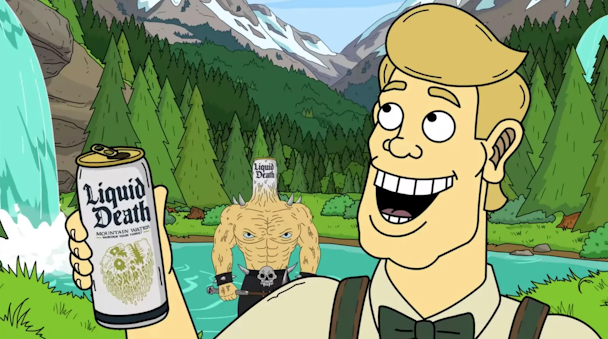Why Liquid Death is so much more than a promotional fad
Defying Mark Ritson, Defiant’s Will Poskett argues that Liquid Death does, in fact, have a firm grasp of product to match its prowess in promotion.

In many ways, Mark Ritson is the Liquid Death of Marketing. His bold views, no-nonsense tone, and often controversial takes have helped to make him famous in the marketing world. Yet (ironically), his recent take on Liquid Death misses the mark.
In ‘Liquid Death’s fame shows how badly marketers neglect product’ he argues that the brand has been predominantly built on promotion and packaging alone. He believes that Liquid Death is the ‘perfect pin-up brand for a generation of marketers who define marketing as advertising’ and spend their careers ignoring the ‘remaining 90% of our disciplines hinterland’.
Explore frequently asked questions
Typically bold stuff from Mark. Yet it is a point of view that I think is fundamentally flawed.
Is Liquid Death’s product actually any good?
To answer this question truly, we need to consider something Mark skips over. We need to consider the category within which it operates, bottled water.
Bottled water is a commodity.
It is literally water poured into a plastic container. It is a category where little product differentiation really exists. Think about your own interaction with the category and be honest with yourself. As a marketer, have you ever drank a bottle of Evian or Volvic and thought ‘wow this water just tastes so much better or different!’. I highly doubt it.
Now let’s consider a far more important audience.
We know growth comes by appealing to ‘light buyers’ who regularly switch between brands and pay little attention or loyalty to them. Do we think this far more passive audience will muse over the qualities and taste profiles of an almost identical water product more than marketers?
Definitely not.
One of Mark’s biggest issues with Liquid Death is the fact that ‘no one talks about the product’. Yet I challenge anyone to point me in the direction of a marketing keynote focusing on their bottled water brand’s superior taste or unique product qualities.
It simply doesn’t exist because water is fundamentally a commodity.
In truth, the success of the biggest water brands like Volvic and Evian is not down to some radically better product. It is down to the fact they spend millions more on paid advertising and on mass distribution.
However, let’s give Mark the benefit of the doubt for a second.
Let’s imagine product innovation and differentiation might be possible in the bottled water category.
What form might that take?
How about new flavors, product extensions or formats? Well, Liquid Death has done this better than any legacy bottled water brand in recent times. It has released a new range of sparkling water flavors, new product extensions via an Iced Tea range and new formats via ‘Death Dust’.
In short, product differentiation and innovation are very limited in the commoditized bottled water category. Yet despite these limitations, Liquid Death has done more than most to push things forward.
How Liquid Death’s leverages the full four Ps
Moving on from the product let’s now tackle the remaining ‘three Ps’ of marketing.
Firstly, there is no denying that Liquid Death’s promotion is brilliant. With relatively small budgets, it has unlocked disproportionate levels of fame and growth. Yet despite this success, Mark believes that the brand is ‘entirely more famous among marketers than the market it targets’.
Advertisement
While it is true that LinkedIn is awash with marketers showering Liquid Death with praise, it is simply untrue to say that it has failed to grow significant fame with a broader audience.
We know that the share of search is a proven leading indicator for both brand awareness and market share. Understanding this and looking at actual data reveals that Liquid Death’s share of search is actually greater than the biggest bottled water brands in both America and the wider world. Clearly, therefore, Liquid Death’s fame reaches far beyond the marketing community.
One final point about promotion is that it extends far beyond just advertising. Liquid Death’s success is due in large part to its incredibly distinctive branding and package design.
The bottled water category loves to follow a formula of transparent tones and glacial mountains. Liquid Death brilliantly cuts through this sea of sameness with a can that looks more like an energy drink or alcoholic beverage than yet another generic water brand.
Advertisement
And please, let’s also not underplay the importance of the brand being one of the first to ditch plastics and provide water in cans. In a recent IPSOS survey, 87% of consumers agreed that reducing plastic waste is essential, and Liquid Death has cleverly been one of the first brands to truly win on this in the category. Will it be remembered for doing so as the market follows? That remains to be seen, but for now, it is king.
Now, to finish, let’s now turn our focus to the final two P’s of marketing: placement and price.
One of the biggest challenges facing any new drinks brands is that the majority of distribution is controlled by a handful of big brands, such as Coca-Cola and PepsiCo. This model is almost monopolistic in nature and makes it incredibly difficult for smaller brands to compete directly.
The genius of Liquid Death, however, is that its placement strategy enables it to sidestep these challenges. Have you ever wondered why Liquid Death looks more like an energy drink or alcoholic beverage? Well, it’s deliberate.
The brand began by positioning itself as a healthier alternative at bars and festivals, removing the stigma of overtly drinking from a bland bottled water brand. This placement strategy saw it ditch the normal route to market in retail stores controlled by Coca-Cola and PepsiCo and instead grow its disruption via bars, clubs and festivals. The genius of this placement is that it also helped to unlock a more effective approach to distribution.
Unlike traditional retail, American liquor licensing laws had prevented the dominance of bigger beer brands and up to 80% of disruption was still independently owned. As the founder of Liquid Death Mike Cessario explained on a recent episode of the CMO uncensored podcast: “The big beer brands, due to the American liquor laws, are only allowed to own 20% of their distribution network… so 80% of the distribution is still owned by independent family-owned distributors… and they are allowed to carry any brands they want.”
When you understand that, you realize that Liquid Death’s placement strategy has been as pivotal to the brand’s success as its promotional activity. In many ways, its distribution strategy has been as rule-breaking as its ads and communications.
Finally, when it comes to price, Liquid Death is a poster child for the power of brand building.
At a time when many brands are being forced to adopt discounting and price promotion due to a cost of living crisis, Liquid Death is able to secure a price premium and charge more than most bottled water brands.
Why?
Because the brand is so strong.
Final thoughts
Liquid Death has grown from around $3m to $263m in revenue in just under four years. Mark dismisses this success, saying the brand is still ‘miniscule’ in comparison to Coca-Cola and points to the fact it is to even make a profit. What he fails to mention is that Coca-Cola was averaging around nine servings a day in its first year before it moved into bottled distribution. It took many more years for profit to come. Patience isn't one of the 4Ps, but it is an important P.
The truth is, it is popular in marketing to take a swipe at the brands doing things differently and shaking things up. Yet to say Liquid Death is a fad built purely on promotion is simply untrue and fails to acknowledge the brilliant work it has done across both its product range and placement.
So perhaps instead of targeting challenger brands trying to do things differently, we should ridicule those brands that simply spend their way to the top with bland promotions and products that damage the planet.
Will Poskett is an award-winning strategist and the founder of Defiant. Over the last twenty years, he has advised brands including Nike, Adidas, Meta, Rockstar Energy Drink, Coca-Cola and Olipop. Let him know your thoughts on LinkedIn.
Further reading:
